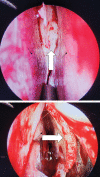Endoscopic Septoplasty: A Retrospective Analysis of Indications and Outcome
- PMID: 37228873
- PMCID: PMC10204915
- DOI: 10.4103/jwas.jwas_247_22
Endoscopic Septoplasty: A Retrospective Analysis of Indications and Outcome
Abstract
Background: Endoscopic septoplasty is a minimally invasive surgical procedure for the correction of nasal septal deformity. Globally, nasal septal surgeries are rarely performed, and in our country these procedures are even more scarcely undertaken, partly due to dearth of facilities and to some extent, the expertise of embarking on this specialised surgical procedure. Therefore, we aimed to document the indications and the outcome of endoscopic septoplasty in our environment.
Materials and methods: This was a retrospective study of all consecutive patients that had endoscopic septoplasty at a state tertiary hospital over three years period. Ethical approval was obtained before commencement of the study. Patients' medical records were retrieved. Biodata, clinical presentation, operative procedure and outcome were extracted and analyzed descriptively.
Results: Fourteen patients had endoscopic septoplasty over the period under review, constituting 11 (78.6%) males and 3 (21.4%) females. Predominant clinical features were nasal obstruction (100%) and nasal septal deviation (100%). The main indication for procedure was deviated nasal septum. The outcome of the surgery was good, 2(14.3%) of the patients had nasal adhesions but no major complication was recorded. The length of hospital stay ranged between 3 and 5 days with a mean of 3.7 ± 0.9 days, and all the patients were discharged successfully.
Conclusions: Endoscopic septoplasty is a safe surgery. The main indication for the procedure was deviated nasal septum, and the procedure has a favourable outcome among the operated patients.
Keywords: Chronic rhinosinusitis; deviated nasal septum; endoscopic septoplasty; indication; outcome.
Copyright: © 2023 Journal of the West African College of Surgeons.
Conflict of interest statement
There are no conflicts of interest.
Figures


Similar articles
-
Endoscopic Septoplasty: A Retrospective Analysis of 415 Cases.Indian J Otolaryngol Head Neck Surg. 2015 Sep;67(3):248-54. doi: 10.1007/s12070-015-0880-1. Epub 2015 Jul 2. Indian J Otolaryngol Head Neck Surg. 2015. PMID: 26405659 Free PMC article.
-
Endoscopic Septoplasty Versus Traditional Septoplasty for Treating Deviated Nasal Septum: A Prospective, Randomized Controlled Trial.Ear Nose Throat J. 2021 Nov;100(9):673-678. doi: 10.1177/0145561320918982. Epub 2020 Apr 27. Ear Nose Throat J. 2021. PMID: 32339048 Clinical Trial.
-
Septoplasty with or without concurrent turbinate surgery versus non-surgical management for nasal obstruction in adults with a deviated septum: a pragmatic, randomised controlled trial.Lancet. 2019 Jul 27;394(10195):314-321. doi: 10.1016/S0140-6736(19)30354-X. Epub 2019 Jun 18. Lancet. 2019. PMID: 31227374 Clinical Trial.
-
Techniques in Septoplasty: Traditional Versus Endoscopic Approaches.Otolaryngol Clin North Am. 2018 Oct;51(5):909-917. doi: 10.1016/j.otc.2018.05.007. Epub 2018 Jul 17. Otolaryngol Clin North Am. 2018. PMID: 30025848 Review.
-
Correction of the deviated septum: from ancient Egypt to the endoscopic era.Int Forum Allergy Rhinol. 2014 Nov;4(11):931-6. doi: 10.1002/alr.21371. Epub 2014 Aug 18. Int Forum Allergy Rhinol. 2014. PMID: 25137431 Review.
Cited by
-
Can 3D Exoscopy-Assisted Surgery Replace the Traditional Endoscopy in Septoplasty? Analysis of Our Two-Year Experience.J Clin Med. 2025 Jul 25;14(15):5279. doi: 10.3390/jcm14155279. J Clin Med. 2025. PMID: 40806901 Free PMC article.
-
Application of the Multi-line Tension-Reduction Technique in the Surgical Correction of C-shaped Deviations of the Nasal Septum.Cureus. 2025 Apr 22;17(4):e82769. doi: 10.7759/cureus.82769. eCollection 2025 Apr. Cureus. 2025. PMID: 40265108 Free PMC article.
References
-
- Hong CJ, Monteiro E, Badhiwala J, Lee J, de Almeida JR, Vescan A, et al. Open versus endoscopic septoplasty techniques: A systematic review and meta-analysis. Am J Rhinol Allergy. 2016;30:436–42. - PubMed
-
- Katherine JR, James O, Nikki R, Deborah S, Denise H, Laura T, et al. Nasal airway obstruction study (NAIROS): A phase III, open-label, mixed-methods, multicentre randomised control trial of septoplasty versus medical management of a septal deviation with nasal obstruction. Trials. 2020;21:1–4. - PMC - PubMed
-
- Jain L, Jain M, Chouhan AN, Harshwardhan R. Conventional septoplasty verses endoscopic septoplasty: A comparative study. People’s J Sci Res. 2011;4:24–8.
LinkOut - more resources
Full Text Sources
